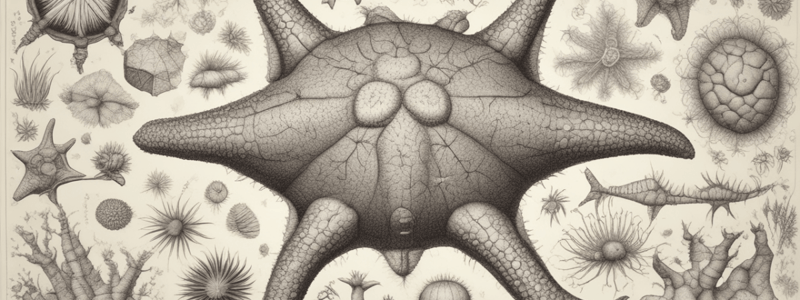Podcast
Questions and Answers
What is a characteristic of deuterostomes?
What is a characteristic of deuterostomes?
- The mouth forms first and the anus forms second
- The mouth and anus form simultaneously
- The blastopore develops into the mouth and the anus forms second
- The blastopore develops into the anus and the mouth forms second (correct)
What is the primary function of the unique circulatory system in echinoderms?
What is the primary function of the unique circulatory system in echinoderms?
- To regulate body temperature
- To maintain internal pressure
- To facilitate movement using their two feet (correct)
- To facilitate gas exchange
What is the purpose of the prezygotic barriers in echinoderms?
What is the purpose of the prezygotic barriers in echinoderms?
- To regulate the release of gametes
- To prevent fertilization between different species (correct)
- To facilitate fertilization between different species
- To increase the chances of successful fertilization
Which of the following is a characteristic of the phylum Chordata?
Which of the following is a characteristic of the phylum Chordata?
What is the function of the notochord in chordates?
What is the function of the notochord in chordates?
What is the relationship between the phylum Chordata and deuterostomes?
What is the relationship between the phylum Chordata and deuterostomes?
Flashcards are hidden until you start studying
Study Notes
- Deuterostomes are a group of animals where the blastopore, the opening into the archenteron, develops into the anus, and the mouth forms second.
- The phylum Echinodermata includes animals with spiny skin, such as starfish, sea urchins, and sea cucumbers.
- Echinoderms have an internal skeleton based on a framework of calcareous plates, which are made up of calcium carbonate.
- These animals have a unique circulatory system where water is circulated throughout the body to facilitate movement using their two feet.
- Echinoderms practice external fertilization, where they release gametes into the water, and fertilization occurs by chance.
- There are prezygotic barriers, such as special proteins, that prevent fertilization between different species.
- The class Asteroidea includes starfish, which have five arms.
- The class Ophiuroidea includes brittle stars, which have five arms but are fragile and easy to break.
- The class Holothuroidea includes sea cucumbers, which have a culinary value in some parts of the world.
- The class Crinoidea includes sea lilies and feather stars, which have a specialized part of the body for anchoring and attachment to the substrate.
- Phylum Chordata includes animals with bilateral symmetry, a true coelom, a single dorsal nerve cord, a notochord, and a post-anal tail.
- Chordates are deuterostomes, meaning the mouth forms second.
- The notochord is a stiff, flexible rod that provides anchoring for muscles and protection for the dorsal hollow nerve cord.
- The phylum Chordata includes vertebrates and invertebrates.
- The two groups of invertebrate chordates are the phylum Tunicata and the subphylum Cephalochordata.
- Tunicates, such as sea squirts, have a notochord during embryonic development but it disappears in the adult body.
- Lancelets, such as cephalochordates, retain the notochord during adult life but it does not develop into a backbone.
- Vertebrates, on the other hand, have a backbone that develops from the notochord and provides protection for the dorsal nerve cord.
Studying That Suits You
Use AI to generate personalized quizzes and flashcards to suit your learning preferences.




